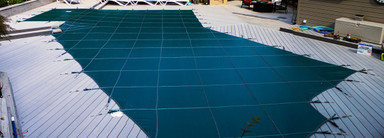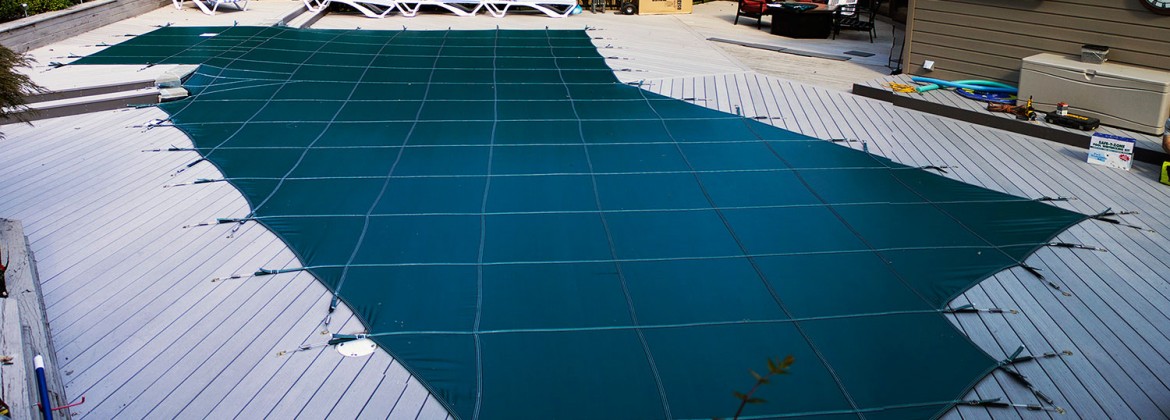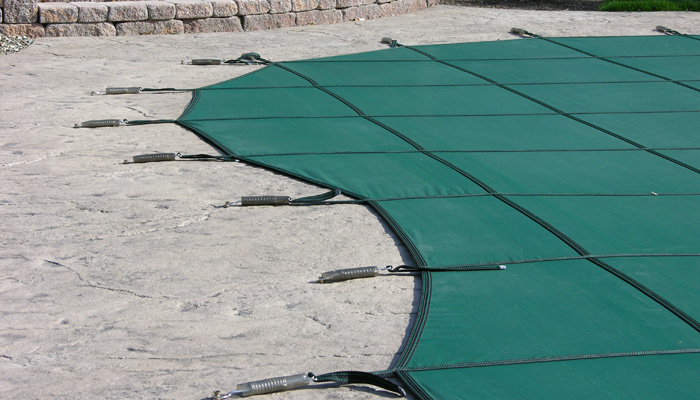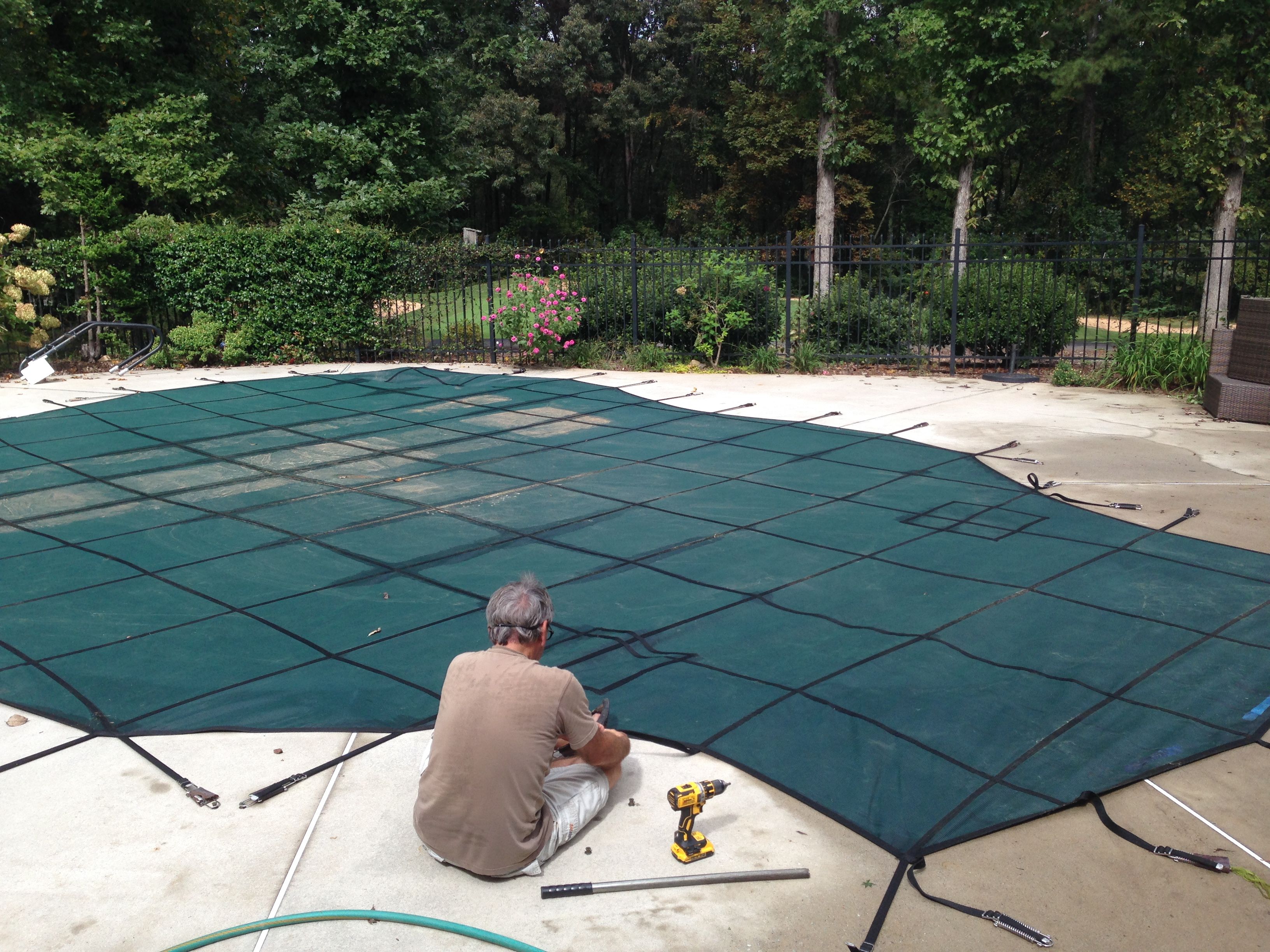Published by EZ Pool & Spa Supply on 07/24/2019
Pool Safety Covers
In certain areas of the country there comes a time of year when the cookouts come to an end, the sun stops shining quite as bright, the temperatures get colder and the fall and winter start to set in. These drastic changes indicate the end of pool season and help in letting you know it may be time to close your pool for the year.
Preparing a pool for seasonal closing can be a task that is sometimes confusing. You will want to ensure that the water in your pool stays healthy during the winter months with the idea being, when the spring and summer weather rolls in again, that preparing for pool opening won’t be a difficult task. So maybe you buy a pool closing winter kit, maybe you follow the directions exactly and set yourself up to be well off in the spring. You’re all good with water chemistry but there is another big item to check-off the pool closing list. You need to find something that protects your water and pool from the harsh winter elements, you need to find a pool cover that works for you and for what you are trying to accomplish.
Pool covers vary in many different ways. Functionality, materials, color, size and method of securing are just some of the ways that covers can be classified. Some pool covers you could actually drive a car on, others are secured by water bags. It really depends on what you are looking for, how much money you are willing to spend, pool location, as well as many other factors.
Pool safety covers are typically designed for weight bearing. If a child, an animal, or a tree branch were to fall on it, it would support both the force and the weight and successfully keep it out of the water and safe. Of course, no one would advise that a child play on any pool cover but just in case, you would have this in place as a safety measure. Also, the sides are expertly secured to the decking so nothing would be able to climb underneath and become trapped. Some critters do in fact, have the ability to crawl through the smallest of spaces so there’s always a small chance of this happening. Something to consider when selecting a pool safety cover is the material that it is made out of. This is typically tied closely to price.
One of the more affordable choices for materials is mesh. A mesh pool safety cover can last at least 15 years, maybe more with the correct care. They are also really light and easy to handle but at the same time can still handle weight, supporting thousands of pounds if needed. Mesh is very porous, allowing rain and melting snow to drain directly into your pool. A positive of this is that water never accumulates on the top of the cover. The mesh material acts like a strainer in that it doesn’t allow any large debris to permeate it and go into your pool. This way, though the water enters, you won’t have things like sticks, bugs, and leaves sunk to the bottom of your pool come spring. The finer sediments such as dust and dirt will be need to be dealt with. Mesh covers also vary in how much of the sun’s damaging ultra-violet rays, some are just advertised as being resistant while others promise to block out 99%.
Another type of safety cover is what is called the “solid cover”. This cover eliminates most all contaminates from entering the pool and helps to further reduce the consumption of pool chemicals during the winter months. This type of cover is usually equipped with a center cover that reduces water (and weight) building up on the cover overall.
It is certainly a very wide range. In the off-season, you may ask “Why does keeping sunlight out of your pool really matter?” and the answer would be that sunlight aids in the growth of algae and the very last thing you want to do is transform your covered pool into a giant algae greenhouse. In order to beat this, either add an algaecide or an algaestat that will remain in your water for an extended period of time during the off-season. Another good piece of advice is to not close your pool if you are aware of algae growth. You’ll want to deal with it before you close your pool for the season, ensuring that your water is crystal clear before being put “to bed”.
The primary reason for your pool’s safety cover is in fact the safety of anyone who may be around. During the winter however, storms may come in that include things like heavy wind and rain and cause the pool to overflow. In this situation the pool cover may actually be in contact with the water and you could actually sink into the water on the above side of the safety cover. It’s a good rule of thumb to stay clear of the safety cover and have everyone else do the same.
Making your safety cover the safest it can be starts with making sure that the cover actually fits the pool in the correct way. The right way of doing this is to take measurements at its longest and widest parts, then choose an option that is constructed to correctly fit your size and shape. Some pools also have special features like waterfalls, to make sure that you are caring for these correctly, we would say that the best course of action would be to check-in with our team or contact the manufacturer directly.
OK, so you’ve done all of your homework, measured correctly, verified that the pool water is clear and now the next step is to setup and install the cover correctly. There most definitely is some variation between above ground and inground cover installation. Inground pool covers typically get anchors put directly into the pool deck. This is usually accomplished by following the install plan that comes with the cover and assists in accurately marking where the anchors will be placed. The next thing is to drill holes that will secure the cover in place. How you accomplish the hole drilling with depend on the material that the surrounding pool deck is constructed from. Whether it’s cement, wood, pavers on sand, or something else, you’ll need to research the hardware required for use with your deck materials. If your inground pool doesn’t have a surrounding deck, you’ll be able to pour concrete footings which can then be utilized to secure the anchors. The special water features that we mentioned earlier will also need special hardware that can be obtained from the manufacturer directly. If you need help with this, we would be glad to assist.
At this point you’ll want to attach the springs to the anchors. Your cover will come with a handy tool that will help to accomplish this by assisting in stretching the springs out onto the anchor. You’ll find this task way too difficult by hand as the spring are wound very tight to allow for the safety cover to work how it was intended.
Safety cover installation can certainly be a task for even the most seasoned of do it yourself veterans. The exact fit and proper installation are critical to the function of the cover. A mistake in the measuring and installation process can possibly decrease the functionality of the cover. If you remain concerned there is always the option of calling on and requesting a professional installer.
Typically, there are two different versions of a safety cover. There are stock covers, that are more readily available for retail purchase or for purchase and shipment. You measure your pool’s length and width from inside edge to inside edge, select your size, and the cover comes with a specific amount of overlap to accommodate a certain variance in the size of pools. The other choice is a custom safety cover which is measured to the exact contours of your inground pool. Custom Safety Covers cost more than stock safety covers because they are engineered, cut, and sewn to fit your pool, and only your pool. Ordering a custom cover is simple, just measure the pool with a long measuring tape, a safety cover measuring form and a CAD design system would be able to triangulate the exact shape of your pool for a great fit.
Another thing to think about is the size of the installation project. We would estimate that a pool cover could be completely installed by two people in anywhere from 2 to 4 hours depending on the size. You will need a rotary hammer drill with a 3/4" masonry bit; both can be rented at any rental shop for the day.
We have great relationships with all of the top cover manufacturers in the country. For above ground pools we offer GLI and for inground, we offer Merlin, and Meyco, as well as Loop-Loc in our retail stores. Our stock of covers is definitely quite extensive. We would love the opportunity to earn your business and we’re happily available to answer any questions when it comes to choosing a cover that works for you! Contact Us Today!









